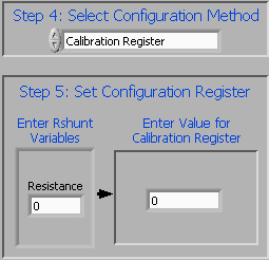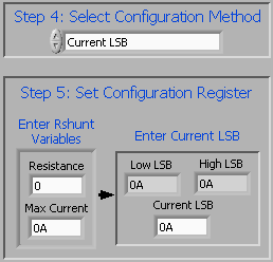SBOU128B february 2013 – july 2023 INA231
- 1
- INA231EVM Evaluation Board and Software Tutorial
- Trademarks
- 1Overview
- 2INA231EVM Hardware
- 3INA231EVM (Rev A) Hardware Setup
- 4INA231EVM Software Setup
- 5INA231EVM Software Overview
- 6INA231EVM Documentation
- 7Revision History
5.2.4 Set Configuration Register
The user must set the Configuration Register correctly for the software to operate properly. There are two methods used to set the Configuration Register: first, the user can manually calculate the desired value and then input that value into the register table, as shown in Equation 1. Alternatively, the user can allow the software to create a recommended window and choose an LSB for the current as shown in Figure 5-7. Both methods accomplish the same goal by using Equation 1, but the method is selected by changing the value in Step 4: Select Configuration Method (as Figure 5-6 and Figure 5-7 show).

The current LSB is calculated by a recommended range in the INA231 data sheet as shown in Equation 2. It is important to note that with either of the methods used, the Current LSB and the Calibration Register values are calculated based on the other variable and the RSHUNT value. See the section Programming the INA231 in the product data sheet for more information on setting the Calibration Register value.

 Figure 5-6 Setting the Configuration Register (Calibration Register)
Figure 5-6 Setting the Configuration Register (Calibration Register) Figure 5-7 Setting the Configuration Register (Current LSB)
Figure 5-7 Setting the Configuration Register (Current LSB)